Text




Knowledge is the most solid foundation for every journey.
4K notes
·
View notes
Text
10 Lessons from a Decade of Writing
Over the last decade, I graduated from high school, got a bachelor’s in writing, earned an MFA in fiction, and started working as a copywriter.
In that time, I grew a lot as a writer — so I thought I’d share the lessons that helped me most along the way!
How does one from each year sound?
2010: Don’t let high expectations be a barrier to good writing
As a teenager, I had unhealthy expectations for my writing. This not only made writing painful, but also held back the quality of my work. Thankfully, in my last year of high school, I had to crank out a short story for a class, with no time to revise as I went. The result? I had fun, and ended up writing a story that was better than anything I’d written before it. That’s when I realized how toxic lofty expectations could become, if left unchecked.
2011: Good stories often depict, or inspire, change
In my first college writing workshop, our professor (of “It’s never about the bread” fame) told us that a good story often does one of two things: it either depicts a change in a character, or inspires a change in the reader. While a bit simplistic, that guidance was invaluable to me at the time. The first option gave me a clear target to aim for in workshop, while option two exposed me to the full, baffling mystery of what makes a story worth telling.
2012: Clear, specific language brings scenes to life
As a sophomore, I fell in love with Raymond Carver’s minimalism and was particularly struck by the following description from “What We Talk About When We Talk About Love”:
Mel handed me the saucer of limes. I took a section, squeezed it over my drink, and stirred the ice cubes with my finger.
The description struck me as remarkably vivid, yet lean — making me realize how a small description could breathe life into a scene when written with clear, specific language.
2013: Personal experiences fuel good writing
After years of avoiding the genre, I took my first poetry workshop as a junior, and SURPRISE. I loved it. It was the first time I’d ever really tried writing about my own experiences, and it brought an invigorating sense of reality to both my poetry and my fiction. It also inspired me to become more observant, which fed back into my writing and made me better appreciate life’s little moments.
2014: Never mow the same grass twice
Throughout college, I had a trumpet instructor who’d often say, “Michael, I hate to mow the same grass twice!” You can find a full explanation here, but long story short, he encouraged me to fix flaws in my performance immediately upon discovering them, because if you repeat mistakes, they become habits. Bad habits that only get harder to break over time.
I didn’t take his advice to heart in my music, but I did apply it to my fiction. In the coming years, it would be instrumental (ha) in honing my craft.
2015: How to tie plot to character growth
In high school, my stories were all plot. In college, my stories were all character. During the first year of my MFA, I learned how to merge the two, by writing narrators with:
Emotions that drive actions,
Actions that trigger consequences, and
Consequences that compel growth.
This structure is simple, but effective, particularly when your character is motivated by a clear emotional struggle. More about this structure here.
2016: Write the stories that excite you
Throughout college, I almost exclusively wrote non-genre stories, because I wanted to pursue particular goals in that space. I learned a lot in the process, but it wasn’t until the second year of my MFA that I realized my stories themselves had lost a certain spark. So I switched back to writing the genre stories I loved. Like an old friend, the spark came back — and the writing got a lot more fun.
2017: Accept that you’ll never catch up to your expectations
The great irony of being a writer is that the more you hone your craft, the further away “perfection” seems. Why? Because as we improve, we not only overcome weaknesses, but also discover the flaws we never knew existed. So we fix those flaws. Discover new ones. Fix them. And so on. It’s a frustrating, never-ending cycle, and it wasn’t until my final year of the MFA that I was able to fully accept it — finding comfort in the fact that my dissatisfaction was a sign of growth.
2018: Be willing to let stories go
In my first year as a copywriter, the fast pace of agency life quickly taught me the importance of knowing when to “let go” of my writing. At work, it was because I had deadlines. But in fiction, I realized I couldn’t keep revising the same stories forever, when others were waiting to be written. “Art is never finished, only abandoned,” said Leonardo da Vinci, and it’s true. Our stories will never be perfect, so it’s our responsibility to decide when it’s time to cut the cord.
2019: If you want to write meaningful stories, start with what’s important to you
After my fiction professor gave that brief explanation (back in 2011) of what made a good, meaningful story, I became obsessed with finding a clearer answer. Something to grasp onto to guide my writing.
But this past year, I realized it was a bit of a fool’s errand. The things that make a story worth telling are incredibly subjective and different for everyone — naturally arising from their backgrounds, desires, fears, and more.
You can’t predict it. Or at least, you can’t predict it well.
So you just need to look inward. To find what you think is important.
And then write.
2020: TBD
Cheers to a new decade, everybody! May we keep honing our craft and fill the years to come with incredible stories.
— — —
Your stories are worth telling. For more helpful tips on how to craft meaning, build character-driven plots, and grow as a writer, follow my blog.
1K notes
·
View notes
Note
Can you do some more body language descriptions? For different emotions like Worry, sadness, love, etc!! Ty🩷🩷
Body Language Descriptions
-> feel free to edit and adjust pronouns as you see fit.
Worry
She wrung her hands together, her fingers twisting nervously as she struggled to keep her thoughts in check.
He glanced over his shoulder, his gaze darting anxiously around the room.
She pulled at her sleeve, the movement repetitive and absentminded as her mind raced.
He bit the inside of his cheek, a habit that betrayed his inner turmoil.
They hugged their arms tightly across their chest, as if trying to hold themselves together.
She paced the room, her steps quick and uneven as she tried to shake off the nagging sense of dread.
Sadness
She wiped at her eyes, even though no tears had fallen yet.
He let his shoulders sag, his whole body slumping as if the weight of the world rested on him.
She clutched her scarf tightly, her fingers gripping the fabric like it was the only thing grounding her.
He kept his head low, staring at the ground as if afraid to meet anyone’s eyes.
They let out a shaky exhale, the sound heavy with unspoken grief.
She blinked rapidly, trying to hold back the tears threatening to spill.
Love
She tucked a strand of hair behind her ear, her smile soft and shy as she met his gaze.
He brushed her hand lightly, the touch lingering just a moment longer than necessary.
They leaned closer, their knees nearly touching, as if drawn together by an invisible force.
She tilted her head slightly, her expression tender and full of quiet affection.
He laughed easily, the sound warm and unguarded, his gaze never leaving her face.
She reached out to fix his collar, her fingers lingering as she adjusted it carefully.
Guilt
He avoided her eyes, his gaze fixed firmly on the floor.
She rubbed her temples, her hands trembling.
He shifted his weight from foot to foot, unable to stay still.
She clasped her hands tightly behind her back, her knuckles white as she fought to remain composed.
They bit their lower lip, their jaw tightening.
He fidgeted with the edge of his sleeve, his movements jerky and hesitant.
Fear
She took a step back, her breath quickening as her eyes darted to the nearest exit.
He clenched the fabric of his shirt over his chest, as if trying to steady his pounding heart.
She froze in place, her body stiff and her movements tentative, like a deer caught in headlights.
He swallowed hard, his throat bobbing visibly as he fought to calm himself.
They pressed their back against the wall, their hands splayed out.
She whispered under her breath, her words shaky and barely audible.
Jealousy
He crossed his arms over his chest, his jaw tightening as his gaze followed her every move.
She tapped her foot impatiently, the rhythm sharp and irritated as she forced a smile.
He clenched his fists at his sides, the tension in his knuckles betraying his calm demeanor.
She cast a sideways glance, her lips pressed into a thin line.
They shifted in their seat, their shoulders stiff.
He ran his fingers through his hair, his movements brisk and frustrated as he fought to contain his thoughts.
Relief
She exhaled deeply, her shoulders dropping as the tension melted away.
He ran a hand down his face, his smile faint but unmistakably genuine.
She laughed shakily, her hand pressed to her chest as if trying to steady her racing heart.
He slumped against the nearest chair, his legs suddenly too weak to hold him up.
They let their head fall back, their eyes closing as a soft, contented sigh escaped their lips.
She smiled faintly, her fingers tracing idle patterns on the surface of the table as the weight lifted from her mind.
Embarrassment
She tugged at the collar of her shirt, her cheeks flushing as she avoided everyone’s gaze.
He rubbed the back of his neck, his lips twitching into an awkward, forced smile.
She bit her lip, her hands fluttering nervously.
He let out a strained laugh, scratching the side of his head.
They hid their face in their hands, peeking out between their fingers with a sheepish grin.
She stumbled over her words, her fingers twisting the hem of her shirt as her cheeks burned bright red.
4K notes
·
View notes
Text
the reason it's difficult to argue abortion with anti abortionists is because for the statement "women's right to bodily autonomy is more important than a stranger's life" to make sense to you, you have to already believe that
women are full human beings (even when they're not wives or mothers)
women have zero moral obligation to sacrifice themselves or produce offspring for society
there is no divine purpose to female anatomy and the purpose of a woman's body is entirely determined by her own self.
women have an unconditional right to defend themselves from violence and suffering of any kind
they legit cannot wrap their heads around that
3K notes
·
View notes
Text
Don’t pause your story to explain characters/character chemistry.
What I mean by this is putting your story to a halt to have a paragraph or two explaining who your characters are in sentences you use on character sheets.
Now I’m not saying don’t use exposition. It’s necessary after all.
But there is a way to get your audience to understand who your characters are without pausing the story progressing. You can tell your audience who they are without it feeling like you’re shoving the info in their face.
I’m going to show an example from one of my own works:
“Charlie Sue is the world of Fate’s well known Chosen One. Every week on Saturday Morning at the strike of twelve, it’s his job to go out on the town to hunt for crimes to fight and bring justice to. However, despite his fame status, he’s rather unenthusiastic of this action, and would much rather keep quiet and curl up in a book to read about the average life of the folk without destinies. But due to his status, he will still do the job and can’t say no.”
“Sherilyn Rosuto, his housemate, is quite the opposite. She loves these crime fighting outings. She’s an action seeking girl at her core, taking interest in the brawling going around town, sports or otherwise. She is loud, carefree, and impulsive in how she approaches things, so Charlie has to keep her in check.”
“Charlie and Sheri are childhood best friends. They care about each other very deeply and want each other to be at their best. Sheri is Charlie’s Number Two. Wherever he goes, she will always be thrilled to tag along. She keeps him motivated about the next outing, whether it be training, or her own enthusiasm. Despite destiny decreeing Sheri as merely a sidekick to Charlie, Charlie truly values her as a good friend he can’t do without.”
What’s WRONG with this?
Well, one, this is a character sheet from mine before I even wrote a draft.
These paragraphs are good at directly telling you who these two characters are and what their dynamic is.
BUT that’s all they do. They put the story in a screeching halt to give the audience this exposition. As a result, it’s telling you how you should feel about them, without actually giving you a reason to care about them or their chemistry.
You can get all this important information across through action and interaction.
Make some key lines implying who they are and what they’re thinking. Making it feel like they are who you want them to come across as.
In this case, two best friends who motivate each other.
So instead of using those paragraphs, I created a whole introductory scene of these two and their dynamic, setting up the action to progress the story.
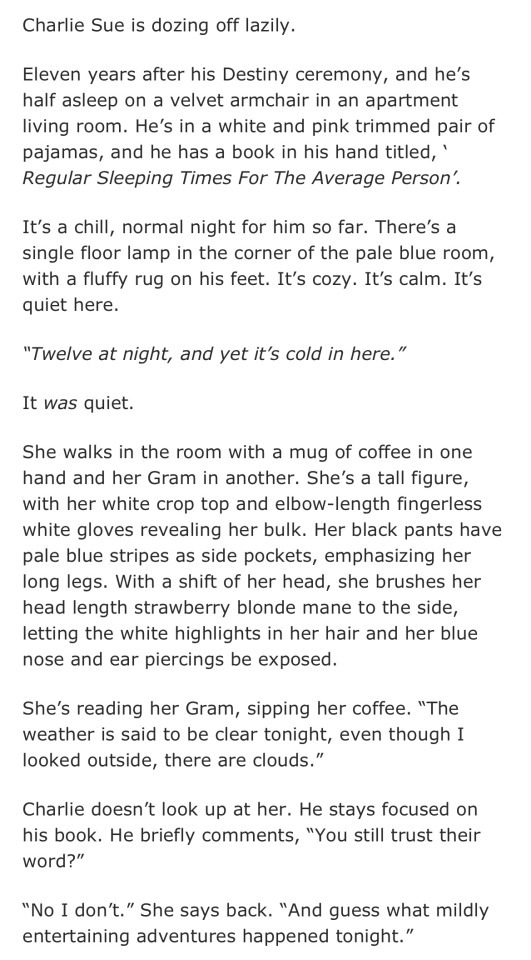

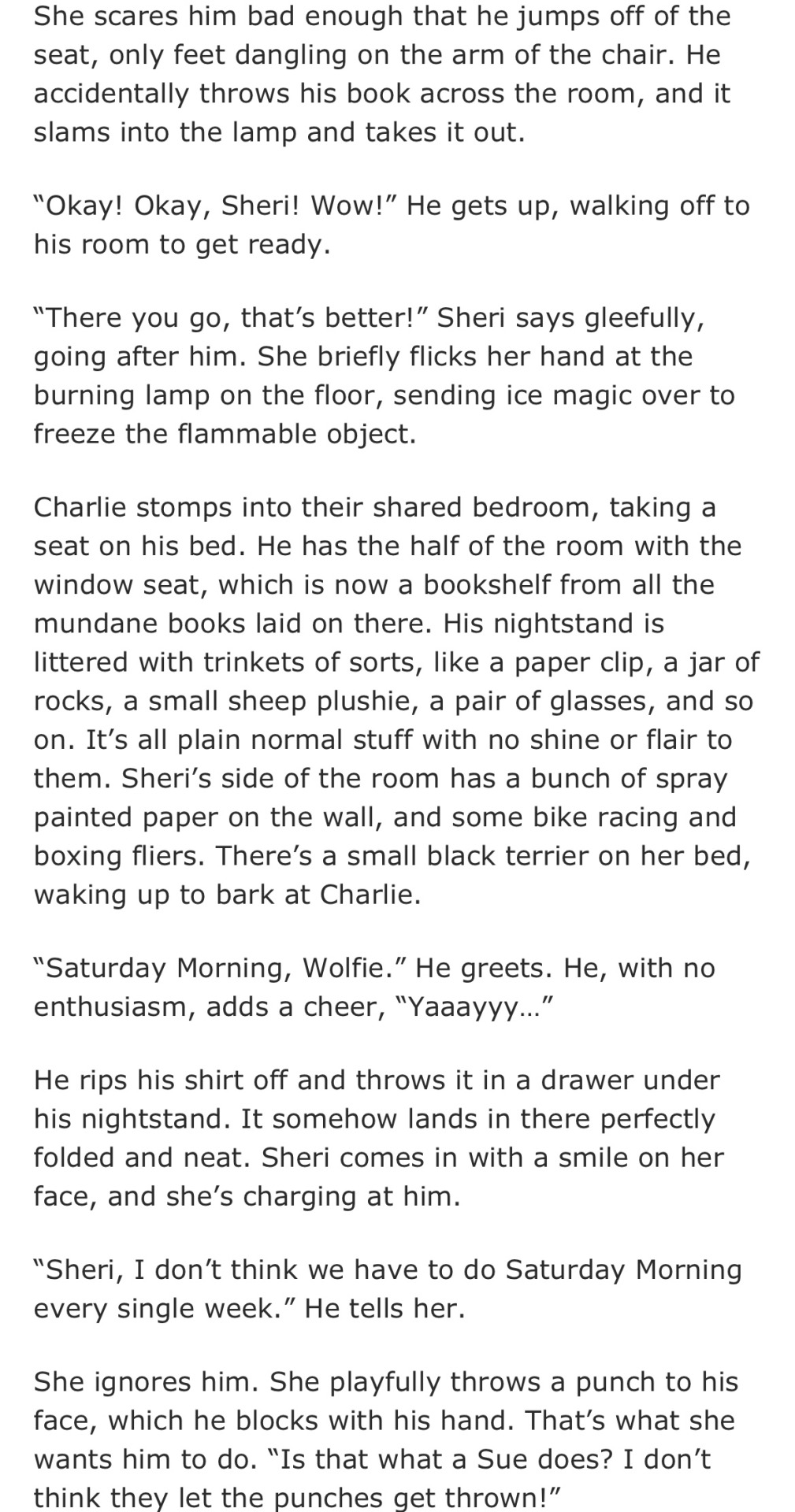

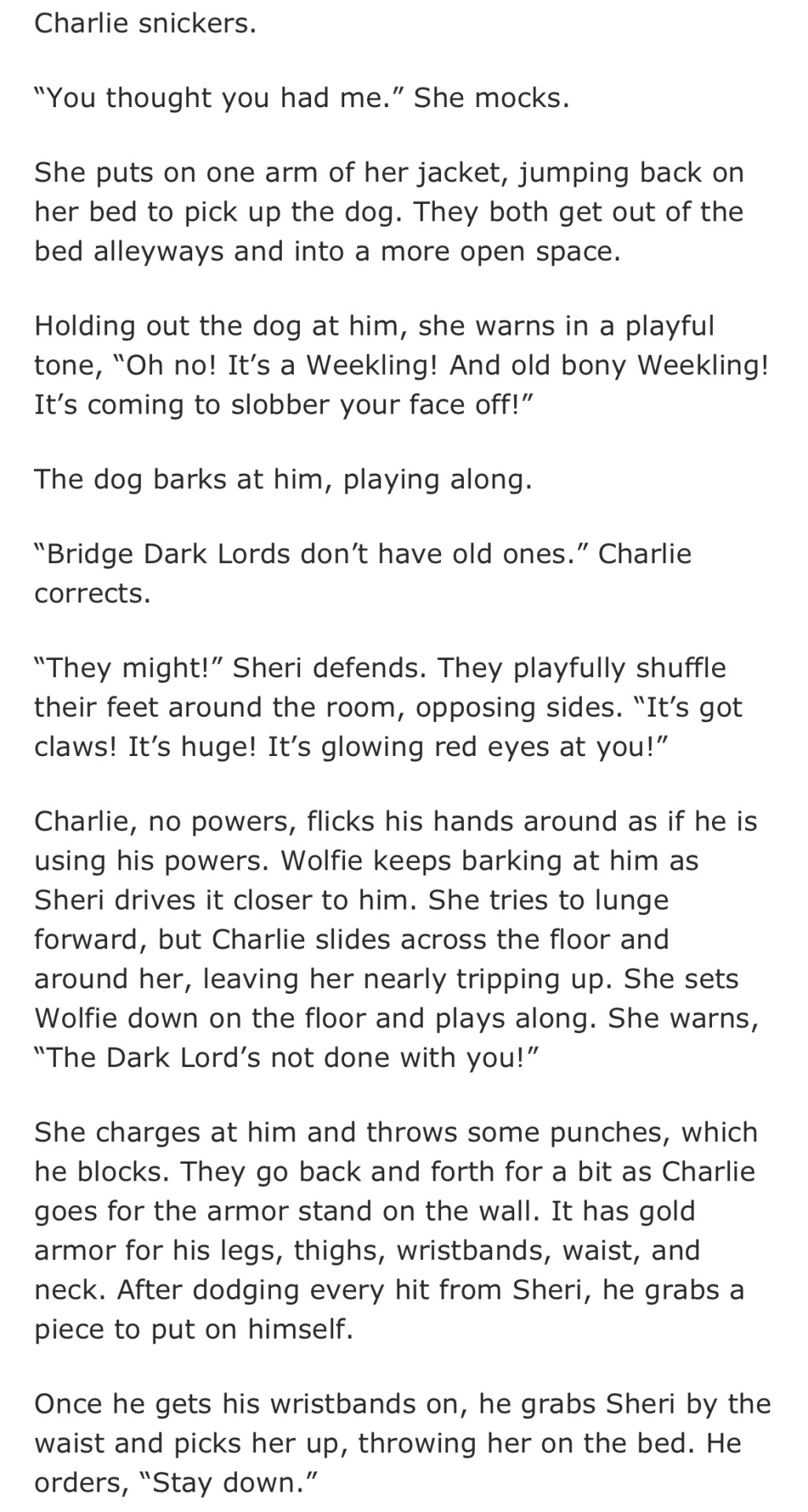
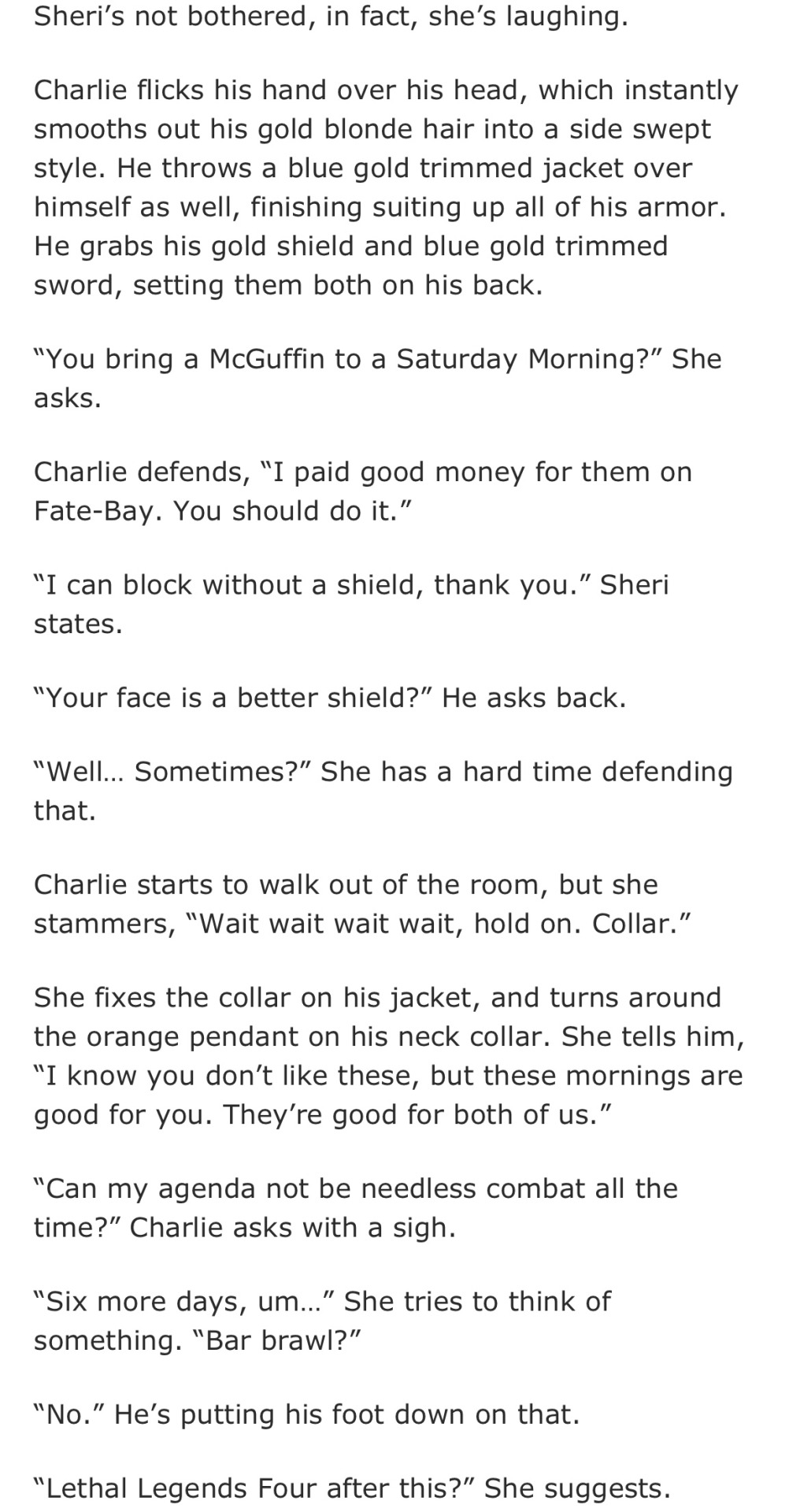

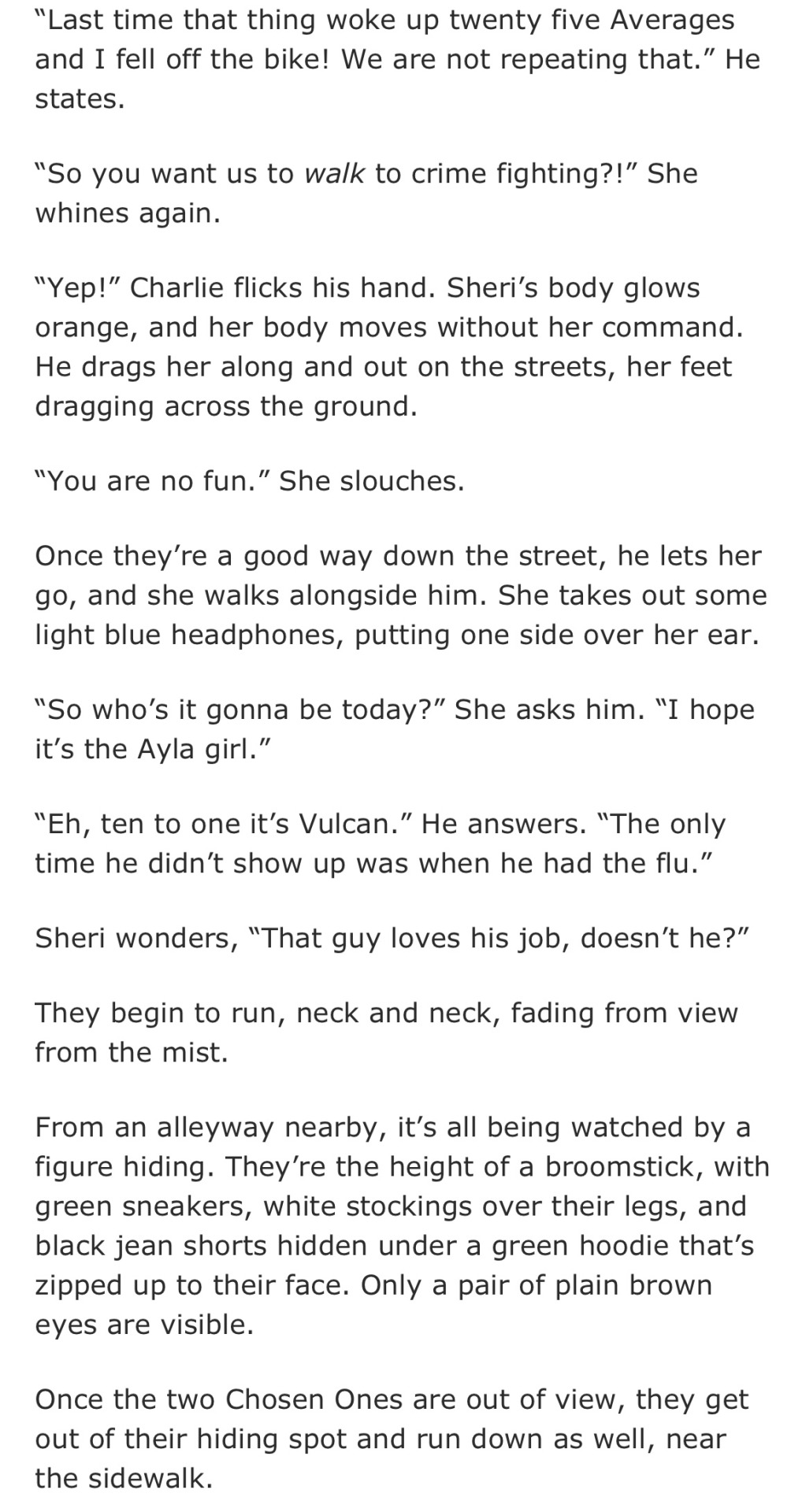
What does this say about them? A LOT, ACTUALLY.
Everything in those paragraphs from earlier is established here, but it’s natural, and not pandering who they are. You SEE how good of friends they are and what their characterization is.
Now granted it’s not perfect, on a Google doc this scene is about 2 1/2 pages so it could be trimmed if you wanted it to be.
Charlie starts the scene lazily reading, establishing not only his interest in books, but what else he takes interest in on what he’s reading. It’s said what the title of the book is. So you get a picture on his interest in the mundane life outside of his current life.
Sherilyn is the one to bring up the time, AKA, what time it is they usually start their outing. And she spends this section trying to strike up a conversation with Charlie to get him to come along.
She also talks about a sports related event, showing she takes interest in that sort of thing. She is also a brawler of the two of them.
Sherilyn also smashes her mug to get his attention, showcasing her loose cannon personality. You can tell from that simple action that she’s not only the talkative loud type, but the impulsive type.
Charlie’s clumsiness is also shown here as he accidentally breaks a lamp throwing his book. (Lamps breaking is a running gag throughout this book btw)
Sheri also has ice powers. That’s shown as she uses it to take care of the lamp mess.
You also get a description of their sides of their room to get more sense of their personality. I personally love these sorts of setting descriptions, especially if they’re telling you something about their characters. Charlie has some more of those mundane books, again, bookworm into mundane stuff. There’s some trinkets on his nightstand, implying that Charlie likes collecting these mundane non-magical things. Sheri meanwhile is an artist, a spray painter to be exact, and she’s a bike rider and a boxer, those are the kind of things she does, and the sports she’s into.
Charlie also sarcastically cheers for the day at their dog, again showing he doesn’t actually like these outings.
Sheri then, playfully, gets them warmed up for this outing to motivate him. Which starts more of their banter and interactions to understand both their characters and how good of friends they are.
Charlie comments against not showing off his body, telling us he doesn’t like that kind of exposure.
Charlie mentions Sheri dreamed of getting muscle since her twelfth birthday. Indicating that these two have been friends for quite awhile. (They’re seventeen.)
Sheri also uses the dog to describe something world building wise. Weeklings. Which are implied in this scene to be monsters by Sheri’s playful description. Charlie also comments that Bridge (location) Dark Lords (character group) don’t usually carry the kind Sherilyn is describing. Telling us where they are on the worlds map and how low the threat level is where they’re at.
These two also have playful banter regarding weaponry, in a friendly way. Telling us Sheri doesn’t use weapons, and Charlie advices she try it, showing concern for her when he asks if her face counts as a shield.
Sheri gives some encouragement to Charlie. She understands him and that he doesn’t like these outings, indicating familiarity and that she’s known him for awhile. She cheers him up a bit by suggesting going to a movie afterwards. Not a bar brawl lol.
You also see how Charlie is the cautious one by speaking against taking a motorcycle to their outing. And Sheri is the athletic one and wants her friend in top shape.
SO MUCH INFORMATION AND SO MUCH CHARACTER, AND BARELY OF IT IS NARRATED DIRECTLY. YOU SEE IT NATURALLY.
This whole scene is meant to be a character establishing scene that helps you understand the main characters and to get the action of the story started. The crime fight outing they’re going to kickstarts the entire plot.
Show Don’t Tell. Move the story along.
If a scene isn’t progressing the story, it should be telling you something about characters and why the audience should care about them.
Your audience should be shown why they should care about your characters and their dynamics. By getting to know who they are and why they either care about each other or don’t.
65 notes
·
View notes












